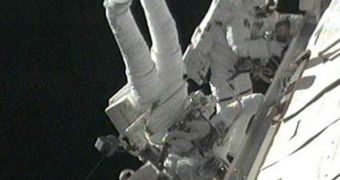Two astronauts from the crew of space shuttle Atlantis managed to successfully complete all of the tasks allotted to them in the third spacewalk of the STS-129 assembly mission to the International Space Station (ISS). The third and last extra-vehicular activity (EVA) of the Atlantis flight took place yesterday, but began with a small delay. Mission specialist Robert Satcher, Jr. found a small glitch on spacesuit, and so he and colleague Randy Bresnik, alongside other astronauts aboard the ISS, worked on fixing the issue for a short while, before the first two finally stepped outside of the facility.
The problem was minor. The valve on the spacesuit's drinking bag, which allows its wearer to drink water during the spacewalk, showed signs of malfunction, so the crew took their time in changing it. After that, Bresnik and Satcher were good to go and they proceeded towards completing the main two objectives of yesterday's EVA – installing a new scientific experiment on the outer hull of the station and replacing an oxygen tank. The two spacewalkers stepped outside at about 8:24 am EST (1324 GMT), roughly an hour later than originally scheduled, Space reports.
In spite of the delay, the two astronauts were able to make up for most of the lost time and finished their activities just shortly after the initially-allotted time. They stepped back through the ISS hatch at 2:06 pm EST (1906 GMT). The experiment that was installed yesterday is meant to test two new types of materials. The first is made out of nanoscale alumina particles and polytetrafluoroethylene (PTFE), also known as Teflon. The end-result is a product that is stronger and more durable than conventional PTFE. The second material is a conductive polymer nanocomposite (CPN).
“We're very excited to have this experiment installed in the ISS, and to see how the new material performs in space. In a laboratory setting, the wear rate of the material is four orders of magnitude lower than pure PTFE [polytetrafluoroethylene], which means it is considerably more resistant to wear and tear. Just as important, these advances don't increase the material's coefficient of friction, which means the increase in durability won't come at the expense of creating extra friction,” RPI Department of Materials Science and Engineering Professor Linda Schadler said before the launch.
Atlantis is scheduled to remain docked to the ISS until tomorrow. After it leaves the orbital outpost, it will perform the second heat shield inspection on Thursday, using the sensor pole instrument. The check-up is meant to ensure that the sensitive tiles that make up the shuttle's only defense against the scorching temperatures of atmospheric reentry is in one piece. After that, the shuttle is scheduled to land at the Kennedy Space Center (KSC), in Cape Canaveral, Florida, on Friday. In case of emergency, the strip at the Edwards Air Force Base (EAFB), in California, is also opened to the spacecraft.

 14 DAY TRIAL //
14 DAY TRIAL //